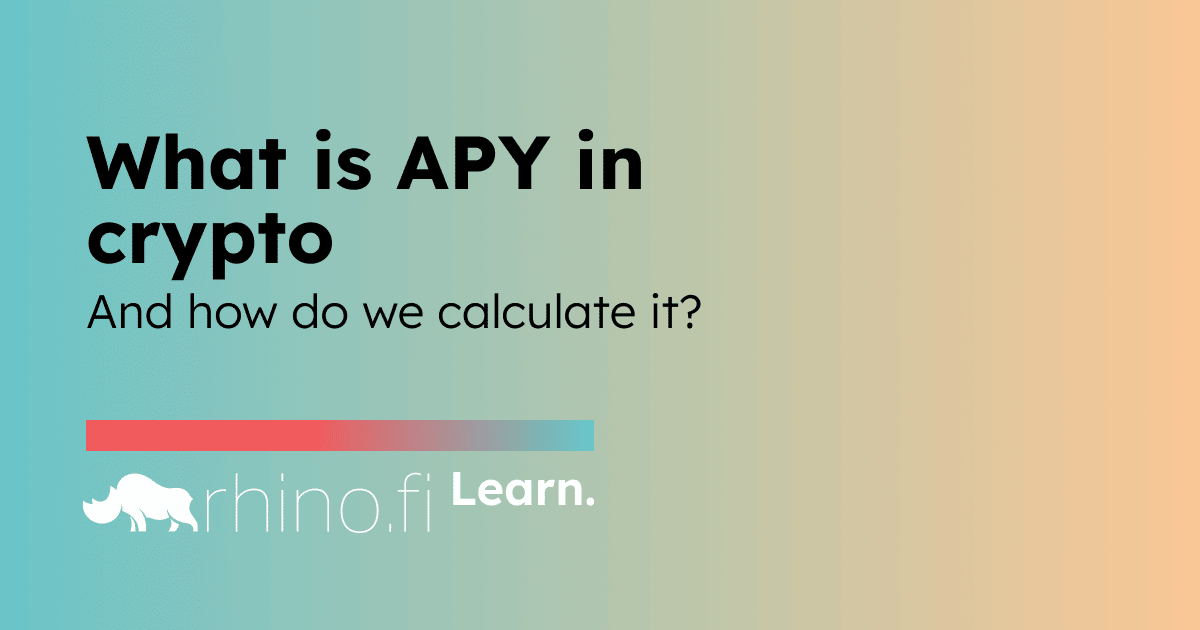Crypto’s bear market has been plagued by precipitous price plunges. The value of Bitcoin, Ethereum and other popular currencies has fluctuated by over 50% in the past year, and the UST stablecoin even collapsed to zero from its dollar peg.
In this climate, traders are increasingly looking towards passive-income opportunities, which allow you to stake or invest your crypto and receive a steady return over time (think a bond or U.S. Treasury in the old world, but made digital). By committing your tokens in this way, you’re increasing overall ecosystem liquidity or supporting the work of validators, and diversifying your own portfolio in the process.
However, before you dive into one of these opportunities, it’s important you know exactly what return you will get. You may have seen a crypto project promising you 5%, 10% or even 20% returns, but what does that actually mean in practice?
Well in all likelihood they’re referring to the APY, which determines the total amount of interest that you will earn each year (in fact if you’ve been around the scene a while, you’ve probably seen some projects promising the ‘best APY in crypto’ or something similar).
Now we know what you’re thinking: this is just the interest rate, right? Well no actually, because APY also takes the effects of compounding into account.
Crypto assets are usually compounding investments. This means that, instead of simply collecting a flat yield once a year, they harvest, and reinvest, the yield at intervals to boost your rewards.
At each compounding period, the interest is added onto your initial investment. Then when the next compounding interval rolls round, the interest is calculated on the updated figure, not the original.
How APY works in crypto: a simple example
Let’s say you’ve invested $1,000 of crypto in an opportunity with a 10% interest rate, which compounds every month. So you will earn 0.83% interest every month, or $8.33 (10% divided by 12).
At the end of the first month, the $8.33 is added onto your initial investment to leave $1,008.33.
The next month, you earn the interest on $1008.33, which leaves you with $1016.73. Your monthly compound figure has risen to $8.40 this month, because it’s based on the new figure, not your initial investment of $1,000.
This carries on for the rest of the year. Each time the compound figure increases a little, because it’s calculated on a bigger base number.
The value of all the interest you earn via these compounding periods over the course of a year adds up to the APY. And this figure will be (usually only slightly) bigger than the headline interest rate.
As you can see, these calculations can get extremely complicated. The example above is actually relatively simple, because it’s based on nice, round numbers.
In reality you may be dealing with much more precise numbers, depending on the interest rate, the amount you’re willing to invest and the compounding frequency. In fact, the compound period can be months, weeks, or even days.
Ok, so how do I calculate APY on crypto assets?
So there’s a basic equation that we can use to calculate APY.
It may look slightly baffling at first glance, and you may even think that some of the calculations are cancelling one another out, like we’re doing two calculations to end up in the same place we started. But don’t worry, we’ll try to explain this.
The equation is APY = (1 + r/n)n – 1.
In this example,
R = the annual interest rate, expressed as a decimal number (so 25% would be 0.25).
N = the number of compounding periods per year.
1 = a baseline that represents your investment.
Now let’s go through it step by step:
First, we divide r by n. This divides the interest rate by the compound frequency to show the interest you earn each compounding period (again, expressed as a decimal number).
Then we add 1 to this figure, so we can see the amount your investment will gain each compounding period.
Now we use the compound frequency (the n value) again to do a ‘power of’ equation. This isn’t a simple one-shot multiplication; effectively, we’re multiplying the same number by itself over and over again. This calculation, which is designed for dynamic and exponential numbers, shows us how much our investment will grow over the course of a year.
Finally, when we subtract 1, we’re effectively taking away the original investment, and leaving only the yield.
Ok, now let’s put this into practice
Let’s say we invest in a yield opportunity with an 11% interest rate which compounds every month.
The equation would be (1 + 0.11/12) to the power of 12 – 1.
So:
0.11/12 = 0.009
1 + 0.009 = 1.009
1.009 to the power of 12 = 1.116
1.116 – 1 = 0.116
So the APY is 11.6%.
As you can see, the APY is fairly similar to the interest rate, but it’s slightly higher because of the compounding.
If you don’t feel confident doing the calculations yourself, you can always use an APY calculator like this one (there are loads of others online).
APY vs APR: What’s the difference?
This is something we get asked a lot. Many people are familiar with the APR, or annual percentage rate, from the fiat world. Why don’t we use it in crypto?
Well the APR is much more closely correlated to the interest rate. In fact it typically is the interest rate, with fees factored in as well.
So the APR is great for flat numbers, but it isn’t particularly useful for compounding assets which are multiplying against themselves every few months. As we mentioned at the top, crypto tends to prefer compounding assets, which is why we typically prefer APY to APR when demonstrating the returns you’ll make.
So what’s a ‘good’ APY to aim for?
This really depends on what you’re looking for.
Just like in the fiat world, higher yields typically mean riskier investments. So if you see something offering 30% or 40% APY, that may mean it’s dubious or unsustainable.
APYs have actually come down a lot in the last few months: annual returns of 20% were once commonplace, but now we’re typically seeing figures between 5% and 10%.
This is a good thing, as it means the market is maturing. Traders, and projects, are less desperate for easy credit than previously, which shows we’re entering a more solid, sustainable phase.
Ok, so how do I research a project once I’ve seen the APY?
Essentially, the metrics you should use are the same as those we outlined in the how to judge a project learn post. Check out the founders, the tokenomics, the initial coin offering (ICO) and anything else you can find, really.
Or you could just use rhino.fi.
We curate a handful of the best opportunities on our platform, and we do the due diligence for you. We never, ever list a passive-income opportunity unless it’s 100% legit. Even if that means we skip the opps with the highest APYs, it’s a price people will be willing to pay.
In fact we’ve just launched a new icETH opportunity. To check it out, just visit the Invest section of our app.





